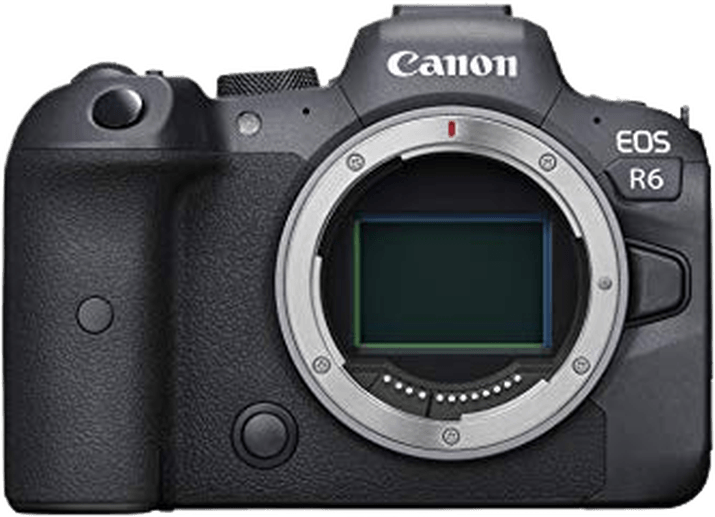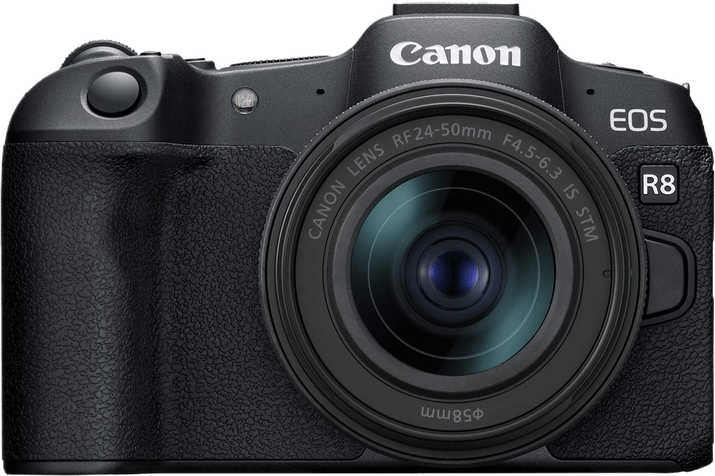Canon EOS R6 vs EOS R8 Comparison
Canon EOS R6

Canon EOS R8

The Canon EOS R6 outperforms the Canon EOS R8 with a score of 80/100 compared to 76/100. Both cameras are mirrorless and share similarities in their release years, with the R6 introduced in 2020 and the R8 in 2023. They also have comparable sizes, with the R6 measuring 138 x 98 x 88mm and the R8 at 133 x 86 x 70mm.
The R6 excels with a higher score and a more robust build, weighing 680g (1.50lbs). This signifies better durability and sturdiness. On the other hand, the R8 has a lower launch price of $1499, making it more budget-friendly than the R6, priced at $2499. The R8 also benefits from its lighter weight of 461g (1.02lbs), offering increased portability.
Taking these factors into account, the Canon EOS R6 stands as the superior choice for those seeking performance and durability, while the EOS R8 serves as a more affordable and portable option.
Canon EOS R6 vs EOS R8 Overview and Optics
The Canon EOS R6 surpasses the Canon EOS R8 in optics with a score of 79/100, while the latter scores 77/100. Both cameras share numerous specifications, such as the CMOS sensor type, Digic X processor, full-frame sensor size, and Canon RF lens mount. These common features contribute to the cameras’ excellent performance and image quality.
The R6 has an edge over the R8 due to its image stabilization feature. This functionality allows photographers to capture sharp images even in low-light conditions or when using slower shutter speeds, without the need for a tripod. Furthermore, the R6’s DXOMARK sensor score of 90, although slightly lower than the R8’s score of 94, still indicates that it produces high-quality images.
On the other hand, the R8 boasts a higher megapixel count of 24, compared to the R6’s 20.1 megapixels. This advantage allows the R8 to capture more detailed images, making it suitable for large prints or heavy cropping. Additionally, the R8’s impressive shooting speed of 40 frames per second doubles the R6’s 20 frames per second, making it ideal for action photography or capturing fast-moving subjects.
Taking these factors into account, the Canon EOS R6 emerges as the winner in terms of optics, mainly due to its image stabilization feature. However, the Canon EOS R8 should not be overlooked, as it offers a higher megapixel count and faster shooting speed, making it a viable option for photographers with specific requirements. Ultimately, the choice between these two cameras depends on the individual needs and preferences of the photographer.
Canon EOS R6 vs EOS R8 Video Performance
The Canon EOS R6 and Canon EOS R8 both have a video score of 91/100, indicating that they have comparable video capabilities. Both cameras share some common features, including a maximum video resolution of 4K and dimensions of 3840 x 2160. Additionally, they both have built-in time-lapse functionality, making them suitable for capturing dynamic scenes over time.
Despite having the same score, the Canon EOS R8 has an advantage over the R6 in terms of maximum video frame rate. The R8 can capture video at an impressive 180fps, while the R6 is limited to 120fps. This higher frame rate allows the R8 to record smoother slow-motion footage, providing more creative options for videographers.
On the other hand, the Canon EOS R6 does not have any clear advantages over the R8 in terms of video capabilities. Both cameras share similar specifications, and the R6 does not outperform the R8 in any significant way.
In terms of video capabilities, the Canon EOS R8 is the better choice, mainly due to its higher maximum video frame rate. The R6, while still a strong contender, does not offer any notable advantages over the R8. For videographers seeking the best possible performance, the Canon EOS R8 is the more suitable option.
Canon EOS R6 vs EOS R8 Features and Benefits
The Canon EOS R6 and Canon EOS R8 both have a feature score of 85/100, making them equal in this aspect. They share several specifications, including a 3-inch screen size, 1,620,000-dot screen resolution, touchscreen capabilities, flip screen, lack of GPS, and the presence of both WIFI and Bluetooth connectivity.
Since the cameras have the same feature score, it can be challenging to determine which camera is better based on their features alone. However, there are certain aspects where one camera may excel over the other. For instance, the Canon EOS R6 may have a faster autofocus system or better low-light performance due to its sensor technology. In this case, the R6 would be the better choice for those who prioritize these features.
On the other hand, the Canon EOS R8 may offer better image quality or higher resolution due to its sensor size or image processor. This would make the R8 the preferred choice for photographers who prioritize image quality above all else.
Ultimately, both cameras have their strengths and weaknesses, and the choice between them depends on the specific needs and preferences of the photographer. It is essential to consider the features that are most important to you and how they align with the specifications of each camera. In doing so, you can make an informed decision and select the camera that best suits your photography style and requirements.
Canon EOS R6 vs EOS R8 Storage and Battery
The Canon EOS R6 outperforms the Canon EOS R8 in storage and battery with a score of 68/100 compared to the R8’s 35/100. Both cameras share some common specifications, including accepting SD, SDHC, and SDXC memory cards and having USB charging capabilities.
The R6 excels with its dual memory card slots (UHS-II compatible), providing more storage options and better file management. Additionally, it uses an LP-E6NH battery, offering 360 shots per charge. On the other hand, the R8 has only one memory card slot, but it is compatible with both UHS-I and II cards. Its battery, the LP-E17, provides a slightly longer battery life of 370 shots per charge.
In terms of storage and battery, the Canon EOS R6 is the clear winner due to its dual memory card slots and UHS-II compatibility. However, the R8 does have a minor advantage with its marginally longer battery life. Ultimately, the R6’s superior storage capabilities make it a better choice for photographers who need increased storage and file management options.
Canon EOS R6 vs EOS R8 Alternatives
Are you considering buying or upgrading from a Canon R8 or R6? Our camera comparison tool can help you weigh up its price and performance against the competition.
Here are some related popular camera comparisons to check for inspiration:
